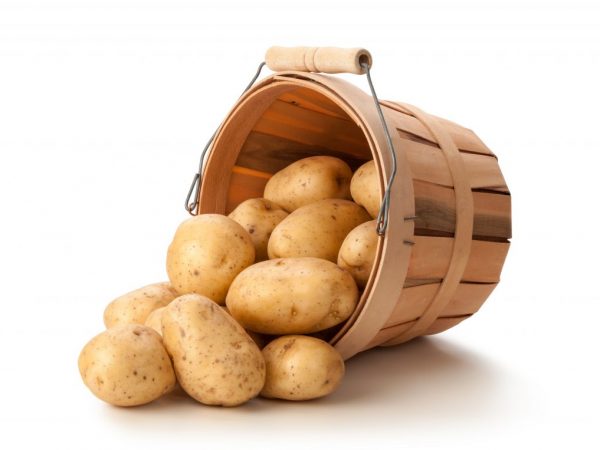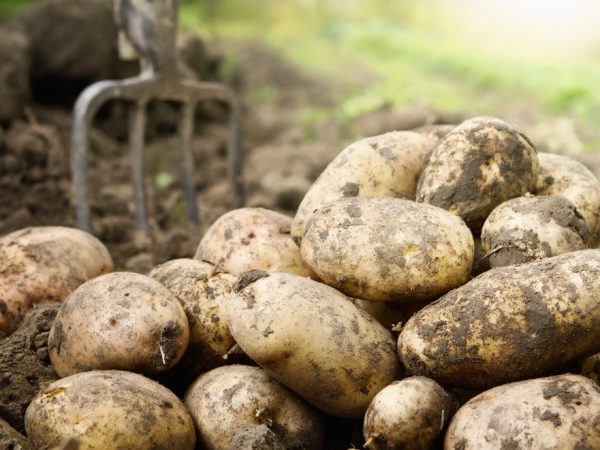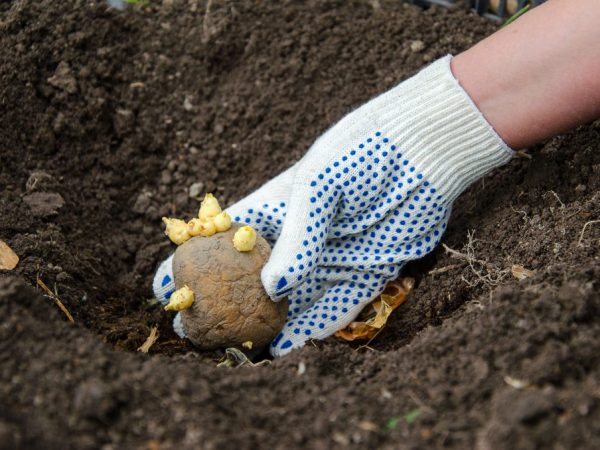Characteristics of the potato variety Udacha
The most popular vegetable, which no housewife can do without, is potatoes. There are dozens of varieties that differ from one another in terms of ripening, taste, shape and color of tubers. But varieties that are adapted to growing in different climatic conditions and at the same time do not lose their taste characteristics are especially popular with gardeners. One of these varieties is the Luck potato. Description of the bush and characteristics of the potato variety Luck will help to choose the cultivation of this particular vegetable crop.

Characteristics of the potato variety Udacha
Characteristics and features
Potato variety Luck is a table variety and has some peculiarities.
- It is early ripening.
- It tolerates drought and heat well.
- The variety is very productive, the yield easily reaches 50t / ha.
- One bush carries up to 20 tubers, and the weight of one tuber can be up to 150g.
From planting tubers in the ground to harvesting, no more than 90 days pass. Even if you start harvesting tubers 1.5 months after planting, you can get early potatoes - 20 t / ha.
Description of the plant
The bush grows up to 50 cm, its shape is spreading, while it consists of 6 - 8 stems. All stems are densely leafy. Leaf shape is easily dissected, potato type. The color of the leaf plate is saturated, dark green.
The bush blooms very profusely. Its flowers are white, with a simple shape common to nightshade crops. They are collected in loose brushes. After pollination, few berries with seeds are tied. Seeds are used by breeders as planting material when creating new varieties.
Advantages of the variety
Potatoes Luck has a number of advantages.
- Tubers begin to sprout at 10 ° C.
- With long-term storage, the presentation and taste are preserved.
- Potatoes are resistant to damage and suitable for mechanical harvesting.
- The plant is immune to most nightshade viruses.
- This potato does not lose its shape and taste during any heat treatment.
The ability to tolerate weather changes well, makes it possible to plant tubers in April, in the central regions. And in the northern part of the country, planting dates are shifted to mid-May.
Under optimal wintering conditions, tubers are stored until the next harvest. The temperature should not be such that they germinate.
Potato Luck is immune to the following diseases:
- scab;
- rhizoctonia;
- wrinkled mosaic;
- cancer of nightshade crops.
And the plant is extremely rarely affected by viral infections. Based on consumer reviews, we can say that this potato variety belongs to the most delicious varieties. It is ideal for frying, baking and mashing.
Disadvantages of the variety

The variety has few flaws
Compared to the number of pluses, this potato has only a few disadvantages.
- When planting, you need to ensure that there is no thickening of the plants.
- It is recommended to plant the planting material at a soil temperature of at least 15 ° C.
- The bush can be affected by late blight of stems and leaves, Alternaria and golden nematode.
If the stems of the bush do not have freedom of growth, then they will be thin, which will significantly affect the yield.
At low temperatures, the root system does not develop well. This becomes the reason that few tubers are tied. Consequently, either the yield will be less, or the ripening period of the potatoes will stretch over time.
How to prepare for planting potatoes
Before planting potatoes, you need to make sure that the soil is properly prepared. Sometimes it is possible to conduct a chemical analysis of the soil and determine the presence of useful trace elements in it. But when growing vegetables on a personal plot, the owner must know when organic fertilizers and other substances were previously applied. With the correct calculation, he will be able to add and introduce into the soil, preparations that are not enough for the full growth of plants.
It is necessary to check the quality of the seed potatoes, the presence of sprouts on the tubers. Sorting of the planting material by the size of the tubers will also be important. This is necessary in order to plant smaller potatoes not as deep as large ones.
Soil preparation
The main rule for growing potatoes is crop rotation. In areas where other nightshade crops were grown, potatoes cannot be planted for 4 years. The best predecessors for it will be legumes, which accumulate nitrogen in the area of rhizomes. It is necessary for all, without exception, plants for growth.
The soil is prepared in the fall, digging deeply, but before that you need to add up to 40 buckets of humus per 1 hundred square meters. Then it will be soft, and the potatoes will be able to form tubers freely. Before planting potatoes, the soil must be treated with urea: 1kg per 10m² of area.
Seed preparation
The preparation of seed potatoes consists of several steps.
- Choose tubers of small size, not damaged by rot.
- They are put on germination a month before planting.
- The temperature must be at least 18 ° C.
For planting on the plots, tubers weighing no more than 80g are selected, healthy in appearance. But the potato of the Luck variety grows very large, so it is cut into pieces before planting. The incisions are made along the tuber, with a sterile knife, taking care not to damage the sprouted sprouts.
If there are at least 4 eyes on each section, then this will be enough to form a bush. Sections should be powdered with wood ash or allowed to dry.
After that, the delenki are placed in boxes in a thin layer and set to germinate. When the boxes are exposed to light, the tubers will accumulate solanine, which will help them fight pests. Sometimes, in order to form the roots faster, the tubers are placed in boxes on the ground.
Planting potatoes

Tubers are laid out with their eyes up
The characteristics of the variety and reviews of experienced gardeners recommend planting plants on the ridges on clay soils. It is necessary to form the ridges so that their height is at least 20 cm, and the distance between them is about 80 cm. So the roots will warm up better and the access of moisture will improve, in case of watering.
In regions where black soil prevails, growing on the ridges is not relevant. The plot can be preliminarily marked into rows, the distance between which should be no more than 70 cm. The optimal distance between the bushes is 25cm.
According to the markings, holes are dug, about 8 cm deep. To each of them, you can add a handful of rotted mullein mixed with ash. Tubers are laid out on them, eyes up and carefully covered with earth, trying not to break off fragile sprouts.
Planting care
If the gardener decides to grow potatoes Good Luck, then the description of planting care will help to organize the work correctly. Plant care is not difficult.
- Removing weeds and loosening the soil is a must.
- You need to spud the bushes as they grow.
- You can fertilize plantings up to 3 times during the growing season.
- It is necessary to fight pests constantly, as well as to prevent diseases.
After emergence, weeding is carried out, destroying the weeds. They do it carefully, trying not to damage the ground part of the plant, and not allowing the root system to be exposed.
Fertilization of plantings
When the bush reaches a height of 20cm, you can huddle it. Before that, in the area of the stalks, ammonium nitrate is scattered at the rate of 0.5 kg per 10m² of area. When hilling, fertilizers will fall into the soil, where they will dissolve under the influence of moisture. When there are dry periods, the plantings are watered, while making sure that the soil near the bushes is not washed out.
Other drugs that are used to fertilize potatoes are potassium sulfate, superphosphate, and dolomite flour. In their mixture: 20 g of potassium sulfate, plus 30 g of superphosphate, plus 500 g of dolomite flour, you can add 20 g of ammonium nitrate. These components are added to 10 kg of humus, mixed thoroughly and scattered near the bushes during the second hilling. It usually takes about 10 days between feedings.
Pest control
If the plot on which the Udacha variety is grown is not very large, then you can collect the Colorado potato beetle by hand and destroy its eggs. In large areas, folk methods are used to combat this pest or the bushes are sprayed with chemicals.
An interesting method is the method of dusting the bushes with corn flour or gypsum. Getting into the stomachs of beetles and larvae, the flour swells, and the gypsum is cemented. This leads to their death.
To scare off beetles and at the same time additionally fertilize the plants, you can use urea. For 10 liters of water, add 100 g of urea and spray the bushes.
Of the chemicals for pest control of potatoes, we can recommend Prestige, which is used to treat tubers before planting. Plant stems and leaves are sprayed with insecticides Commander, Confidor and Tanrek. They are not washed away by rains and are long-lasting in terms of impact on pests and their larvae.
Fight disease
Potatoes Luck is processed from late blight of the plant's overground mass, Fitosporin. To prevent the spread of wrinkled mosaic, use the mineral oil Sunspray 11 E.
Small insects, especially aphids, are considered to be carriers of viruses. By spraying the plantings with insecticides and destroying aphids, gardeners will exclude the slightest possibility of viruses entering their area from neighboring vegetable gardens that may be infected.
Conclusion
Gardeners, before putting their favorite potato dishes on the kitchen table, need to grow it. Observing the rules of agricultural technology and plant care, you will get an early harvest.
The Udacha variety will delight you with large tubers that can be cooked with herbs and sour cream at a time when other potato varieties are only increasing their green mass. Good preservation of tubers and a taste that is not lost over time will make it possible to feast on your favorite dishes in any months of the year.


